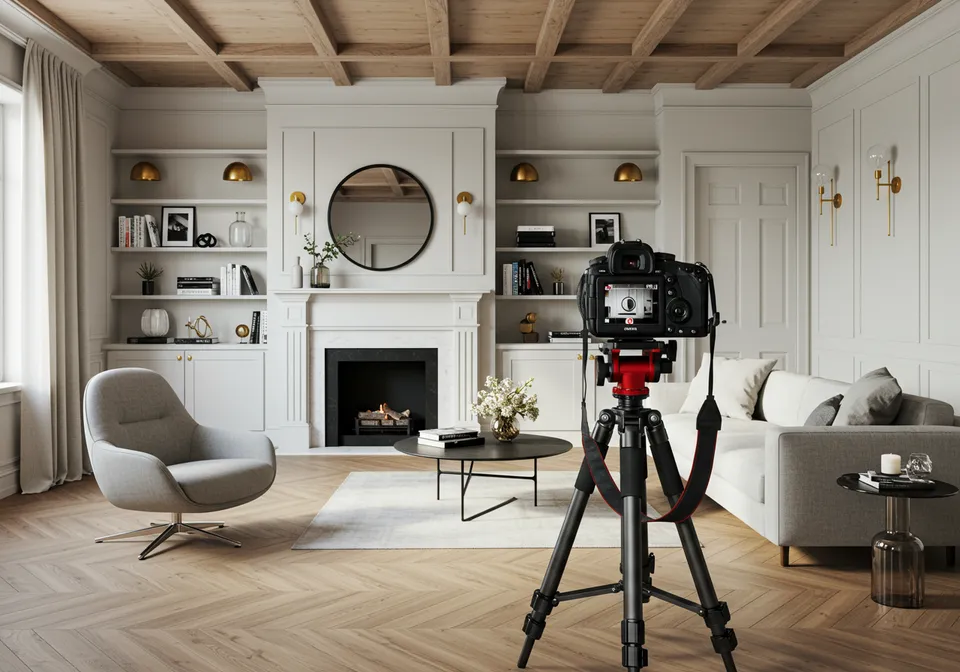
“How do you tell a client you don’t want to post their project on social media?”
That’s the question a member of the Interior Design Community asked recently. What followed was a flood of supportive, savvy responses from designers who had all been there and come out wiser.
Let’s rewind. This designer had guided her clients through an entire remodel. She gave them a comprehensive design packet: floor plans, elevations, finishes, furnishings, everything a flat-fee project should include. The clients loved it. They were excited.
Then they started shopping.
Not from her sources. Not through her. Not with the to-the-trade vendors she’d specified. They replaced her carefully selected pieces with budget versions and online substitutions.
And then they asked:
“What will our hashtag be when you post this on your Instagram?”
Suddenly, she wasn’t excited. She wasn’t proud. She didn’t even know how to respond.
She had done the work. But the finished product, the actual room that would be photographed, posted, and tagged, no longer reflected her vision, her brand, or her standards.
She wasn’t angry. Just caught.
And if you’ve worked in this industry for more than five minutes, you know how it feels. This blog is for every designer who’s had a project go off-brand, off-track, or off the internet entirely, and for those who want to avoid it next time.
When the Client’s Choices No Longer Reflect Your Brand
Let’s start with the heart of the issue: You gave them a design, and they executed part of it. The rest? Budget alternatives, lookalikes, or random last-minute swaps that stripped the soul from your concept.
You’re still proud of your design work. But the finished room? That’s no longer yours.
“I don’t want to be known as a bargain shopping designer,” the IDC member said.
Totally fair.
But now you’re faced with the awkward conversation:
How do I say this without sounding judgmental or ungrateful?
What Designers Said—and What Works
We asked the IDC community how they handle this. Their responses ranged from direct to diplomatic, but all shared one thing: brand protection.
“Now I have a clause in my contract that covers not just if I can shoot it, but when and under what conditions.”
“I once walked into a finished room and it was full of budget knockoffs. It technically followed my layout, but none of the original quality or style was there. I thanked them for following the vision and politely skipped the photography.”
Translation: You can still honor the relationship while quietly stepping away from the spotlight.
How to Handle It: Scripts You Can Use
You don’t need to explain every design decision. But you do need to be clear. Try one of these:
When furnishings were substituted:
“We love to feature projects that reflect our full design intent, especially furnishings. Since your selections are different from the original design, we won’t be showcasing this one, but we’re thrilled you love the space and can’t wait for you to enjoy it.”
If they ask about hashtags:
“We’re so glad you’re excited! For social media, we typically highlight projects where we’ve handled the entire design and installation. Since this one was completed differently, we’ll be skipping this one, but we’re so happy it reflects your style.”
If it’s a partial install or DIY finish:
“Our feed features full-service projects only, since that’s what best represents our work. This was such a fun collaboration, and we’re proud to have supported your vision!”
Kind. Honest. And firm.
When You Can’t Post at All
Sometimes the issue isn’t aesthetics, it’s privacy.
“Some clients ask that nothing be posted until they move out. I always respect that,” said @chrystal.mclean.interiors.
“We’ve had clients so private we weren’t even allowed to take photos,” added @cocodotdesign
In these cases, the decision is out of your hands. But it still raises a question:
How do you show your value when your best work can’t be shown?
7 Ways to Market the Project Without Posting the Final Photos
- Share the Design Story
Talk about the color palette. The layout challenges. The custom details you created.
Use Reels or carousels to walk people through the thinking, even without showing the final result.
- Use Renderings or Flatlays
Create a digital or physical vignette of the design, especially the version you intended.
Say: “Here’s the original design plan we developed for a recent client project.”
- Share Behind-the-Scenes
Installation days. Vendor visits. Moodboards.
“I posted videos of site visits, design boards, and sourcing trips. People loved the behind-the-scenes angle,” said @interiorsbydina.
- Post a Testimonial Instead
Ask the client for a short quote about the process. Pair it with a neutral background or an abstract image inspired by the palette.
- Revisit Old Projects
Use this quiet time to re-edit past photos. Do a “portfolio rewind” or spotlight before-and-after from other jobs.
- Educate Instead of Show
Use the experience as a teaching moment.
You don’t have to call out the client, just talk about how cohesive sourcing impacts results, or what full-service really means.
- Protect the Brand, Not the Ego
You don’t need to prove anything. Not posting doesn’t make the project less real or your talent less valid. It just means it’s not the right fit for your platform, and that’s okay.
The Deeper Strategy: Aligning Expectations Early
By the time a client is swapping your selections, it’s too late to protect the presentation. That conversation has to happen up front.
Include a photography clause in your contract that clearly states:
- Designer controls photo rights
- Only projects completed under your full scope may be photographed or posted
- You reserve the right to decline photography or publicity for any reason
Even better, talk about it during the initial consultation:
- Are they open to photography?
- Do they plan to shop or follow the plan?
- Are they okay with letting your team install and style for photos?
You’ll quickly get a sense of whether they’re your kind of client or just looking for a plan to shop.
What This Says About Your Business
This whole issue boils down to control of your process, your visuals, and your brand.
And in 2025, your Instagram is your portfolio.
Posting a project that doesn’t reflect your design integrity could actually hurt more than help.
“Clients choose us because they know we’ll protect their personal space,” said @thymeandplacedesign. “That becomes part of the value we offer.”
And part of that value is knowing when to say: “This one’s not for the Gram.”
What to Say, What to Do, and What to Avoid
Say:
- “We showcase projects that reflect our complete design vision.”
- “So glad you love the space, we’re proud to have been part of it.”
Do:
- Update your contract
- Have a respectful script ready
- Stay consistent with what you post
Avoid:
- Posting something you don’t stand behind
- Ghosting or avoiding the conversation
- Compromising your aesthetic just to fill the feed
You are the creative director of your brand.
Not every project needs to be a case study. Some pay the bills. Some build a portfolio. Occasionally, you find the rare one that does both.
And when you do? Post the hell out of it.

